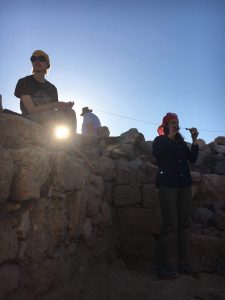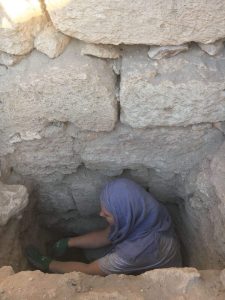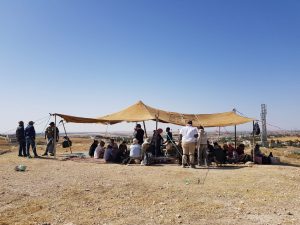
SUPERVISORS DON’T DO MUCH
Maria Gajewska, 2018 Platt Fellowship Recipient
Supervisors don’t do much. At least that’s the impression I got from the excavations I took part in so far. I was digging in the scorching sun, swinging my mattock up and down, doing the decidedly un-

Trying to keep the string steady, remember the measurements, and explain what we’re doing – no wonder posing didn’t quite work out (Salam is providing substantial help by checking the line level on the right.)
ladylike job of stripping off the topsoil for two weeks straight (the joys of excavating a hitherto-unexplored site, where everyone knows there is something under the ground but no one knows quite where, so you move to a new area every Tuesday.) I also cleaned a 16th century skeleton with painstaking care, doing my best not to crack the skull with a dental pick or crumble yet another carpal; rewarded with the sight of a silver, heart-shaped pendant peeking through its ribcage. In both cases, the supervisor presented an imposingly untouchable figure. Well, actually, not necessarily that imposing, more composed and decidedly less-sweaty or panicked or exhausted than me. Understandably, I was thrilled to be invited to supervise an excavation square at Tall Hisban in the summer of 2018. It meant I would go to Jordan for the first time in my life, with a professor whose work I follow and admire, and a team of wonderfully clever and knowledgable students, archaeologists, and historians. Words cannot describe how grateful I am to ASOR and the late Mrs Katherine Barton Platt for the generous grant that allowed me to join the Hisban project. But it also meant I would be a supervisor – an inherently knowledgable and level-headed professional (despite not even having finished my MA at the time,) capable of answering all questions and clearing all doubts while sat on some ancient wall or other. I’d wear a pristine white shirt of the type Mortimer Wheeler favoured. Perhaps, from time to time, my co-workers would bring me a cup of sweet, Arabic tea.
Fast forward to week one of the project and I am indeed drinking off a sweet cup brought to me by one of my co-workers. But the cup is filled with coffee, not tea, and I desperately need this coffee to stay awake at the tender hour of 6 AM. My Field Supervisor and Project Director (the wonderful professor with whom I was so thrilled to work) are giving me pointers on today’s work. ‘Extend this probe.’ ‘Clean that wall.’ ‘Make sure this lens of ash here is a feature.’ Is this a wall or wall tumble, I ask? They don’t know, and now it’s my job to find out.
The Field Supervisor and Director move onto the next square and I return to my team – four brilliant students, three older than me and one more academically senior too, and two local workmen, also older, only one speaking English. My Arabic could be kindly described as ‘budding,’ which is just another way of saying non-existent. They look at me with rapt (if sleepy) attention. I tell them what to do, explain why we’re doing this, and then settle to take a few quick photos of the trench while the light is still good and clear. They pull on their gloves, grab their trowels and buckets, settle to work. I sit down with my blessed pile of paper context sheets and my blessed tablet. It’s the last season of paper recording and the first season of tablet recording at Hisban, which means we – I – have to do both. But at least I get to sit down. My white shirt

Sometimes ‘making the call’ meant sending someone into a hole so deep their head barely peaked out. Here Salam captured Esther in one of her rare moments of visibility (photo credit: Salam Kassem.)
shines in the sun.
Five minutes later the white shirt is smeared with soil (it won’t come off until I soak it in bleach back in London.) We still don’t know whether the pile of stones we’re excavating is a wall or a collapse, and it’s my job to find out. I spend some time scratching it with a trowel and arranging my face into a thoughtful frown. It doesn’t budge. I still don’t know what it is, and my teammate is waiting for a response. She wants to know what to do and I’m supposed to have the answer.
‘Just … work around it gently for now,’ I say, feeling decidedly helpless. ‘I’ll call the director after lunch.’ It’s a poor piece of advice but she takes it and returns to scraping off the surrounding soil quite cheerfully. I need to dash out of the trench and add a quick note on the uncertain status of the wall/tumble on my tablet. And copy it onto the pile of papers.
This situation plays out over and over again through the day, with the wall/collapse and foundation-trench probe, and with the cooking feature too. It plays over the three weeks with just about everything. I dash around, call people, make endless notes and take photos, pull smart faces and try as hard as I can to provide a sort of conceptual grounding for our team. In the afternoons, while most work on their theses and articles or go out for ice cream, the supervisors drink endless cans of iced coffee and pore over the site documentation. I barely touch my trowel, but every day I go to bed exhausted.
I also learn a lot from this exhaustion. Not just that when a supervisor sits down with a context sheet, they’re anything but calm. I learn to interpret changes in soil colour and compaction, and to decide how to proceed with excavating these changes. I learn when to trust my own judgement and when it’s better to call for someone with more expertise. I learn that when you lead, sometimes the best thing is to shut up and listen and you might just learn something new. But sometimes you need to make the call, because nobody else will.
And then there’s that special bond that comes from doing archaeology together. When you see each other at your worst, at 5 am, in your dirtiest clothes, your faces covered
in a mixture of sunscreen and dust that looks almost like a mud facial. The shared excitement over something as simple as a piece of purple glass, because purple means it is earlier than you previously thought, changing your interpretation of the whole excavated house altogether. The overwhelming joy at having to work twice as fast because it comes from discovering something unexpected and exciting. They won’t put that in a BA Archaeology prospectus. That silent understanding, the camaraderie of sitting down in the middle of an ancient tell, a slice of bread dripping with olive oil and zaatar in one hand, a cup of tea in the other, telling stories of curving house walls, ashy pits, and glazed pottery. It doesn’t sound exciting, but it is from these stories that you get Jerash, Pompeii, and ‘I, Claudius’. We know that. So we see our favourite piece of pottery or metal or glass and we smile like veritable idiots.
I could write a lot about the incredible discoveries we made (but I guess you’ll have to wait for the final publication). Of how I learned to excavate houses and floors and hearths. How useful it has been when planning my MA coursework, how useful it will in all likelihood be when writing my PhD proposal. I could also write about the joys of visiting Shawbak with someone who excavated at Shawbak. Or Qusair ‘Amra, that Mecca of every Islamic archaeologist and art historian. Or Petra, the modern Wonder of the World. It all happened, it was all undescribably wonderful, and I have ASOR to thank for that. But I expect what will stick with me is the simple truth – supervisors do a lot, but teams do everything. My team has been wonderful enough to invite me for post-excavation work to the University of Bonn, which is where I am writing this report now, fresh out of my MA, CV dripping with skills acquired in Hisban. Surrounded by friends who understand why a piece of polychrome sgraffito is enough to postpone lunch by half an hour.
Maria is a recent MA Archaeology graduate from University College London. Passionate about Islamic archaeology, she is currently travelling around the Middle East and North Africa, bouncing between archaeology and heritage projects and putting together a PhD proposal in the meantime.

